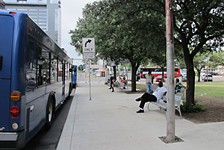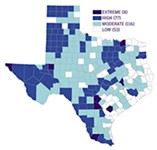Downtown Austin Plan: Why Do It?
Developing Stories
By Katherine Gregor, Fri., March 20, 2009

In a time of economic gloom and city budget-slashing, the Downtown Austin Plan was almost a casualty last week. When City Council was faced with approving the contract for DAP Phase Two – a whopping $841,000 for another 16 months of work by a consultant team led by ROMA Austin – some council members blanched at the cost. As council and staff are searching for $20 million in General Fund cuts and poised to hire a comprehensive-planning consultant for $1.3 million, the Downtown Austin Plan contract suddenly drew fresh fiscal scrutiny. In the end, the final vote was 7-0 in favor. But the day before, according to backroom sources, sentiments ran 3-3-1, with Lee Leffingwell, Mike Martinez, and Laura Morrison unsure they'd vote for the DAP contract.
The DAP's completion has dragged out and increased in cost, while council members and policy priorities have changed. Some current members are fuzzy on the plan's value, on why the city needs to spend so much on a separate Downtown plan or how the final product will be any better than all the other (unimplemented) plans and recommendations sitting on city shelves.
However, the Downtown Austin Plan doesn't drain the city's General Fund. Both it and the Comprehensive Plan are funded with Capital Metro's quarter-cent reimbursements to the city. Those capital funds were assigned by City Council and the Capital Metro board to be spent on planning – Regional Mobility Studies. (Capital Metro lacks the reserves to pay its quarter-cent obligations of more than $85 million to the city; it will meet soon with the city to discuss a payment plan. According to a city representative, the city is "optimistic" that the DAP and Comprehensive Plan will not be affected.) "We cannot use this money for parks, libraries, Police, Fire, et cetera, or any other General Fund expenses," pointed out Council Member Sheryl Cole.
As light-rail advocate Brewster McCracken noted last week, the ROMA contract includes transit planning for the entire streetcar/light rail system – including initial engineering – all the way out to the airport. So the DAP expenditure isn't really just for Downtown: A solid plan for central-city rail transit and transportation is crucial to making the whole region's mobility work. The DAP will include detailed recommendations for central-city affordable housing as well, another regional issue. Both Leffingwell and Cole said they also felt very motivated to get the open-space planning work done for Downtown parks and for historic preservation.
What $841,000 Will Buy
The principle behind the Downtown Plan is that if Austin aspires to become a world-class city – or simply remains a livable city as it grows – it needs to invest in world-class urban planning. A Dec. 15, 2005, council resolution initiated the Downtown plan and the search for a consultant. But the scope of work has expanded over time, along with the budget and the timeline. Getting ROMA under contract has dragged out at various stages; the public input process, the city bureaucracy, and too-thin staff support also have slowed progress. The original council resolution included the following still-pressing goals:
• Modernizing the city's development codes, which govern height and density;
• Developing new funding mechanisms to support infrastructure;
• Planning for transit routes and stations and transit-oriented development around the Convention Center;
• Establishing guidelines for how government-owned land should be made available for development;
• Creating more affordable/work force housing.
Critically, the new land-use rules are to be codified by ordinance, to ensure the DAP isn't just another set of toothless recommendations. Other portions will need to become official city policy as well, then incorporated into capital-improvement plans. If the DAP effort were aborted now, without enforceable ordinances and a detailed implementation plan, then indeed the city might have wasted the $600,000 spent to date. New development-code principles drafted by the ROMA team – if adopted by council – will go to the city legal department (and perhaps more consultants) to be codified into ordinance.
Some council members questioned why a comprehensive plan – for the whole city – is budgeted to cost $1.3 million, while just the Downtown Plan is costing the city more than $1.4 million. They asked if efficiencies and cost savings could be found by combining the two planning efforts. (Morrison moved last week to postpone the contract approval for two weeks, to see if the consultants' work could be scaled back, but her motion died for lack of a second.) The council queries triggered an explanatory memo on the relative costs of the two planning efforts from Greg Guernsey, director of the Neighborhood Planning and Zoning Department. He cited differing levels of in-house staff involvement. They're also different animals: DAP Phase Two requires drilling down to create detailed strategies for getting specific projects done, while the comprehensive plan is more of a conceptual framework.
For the record, the original $600,000 that council authorized for the DAP has covered Phase One services ($165,200, authorized Oct. 5, 2006), additional transit and transportation planning ($240,000, authorized Feb. 28, 2008), plus affordable housing and density bonus planning work ($200,000, authorized March 27, 2008). Some additional services and other city funds got chucked in along the way. For the Phase Two contract, Guernsey gave council this breakdown:
• Policy analysis (music/arts/cultural resources, historic preservation, urban design): $96,000;
• Downtown Parks and Open Space Master Plan: $157,000;
• Downtown districts (identifying and establishing goals, objectives, and priorities for each): $60,000;
• Three subplans: 1) Transportation Framework Plan (further development and update); 2) Infrastructure Improvement Strategy; and 3) Implementation Plan: $96,000;
• Northwest District district-specific plan and Core and Squares District district-specific plans (combined): $131,000;
• Downtown Austin Plan final document (including all stakeholder and public input, town hall meetings, board/commission/council reviews): $216,000;
• Contract administration: $25,000, with $44,000 more reserved for contingencies.
Will council remember its passion for fiscal stewardship after the final Downtown Austin Plan is delivered in 2010? The city has a poor track record of hiring consultants, receiving well-considered expert recommendations, and then failing to decisively and consistently track and implement them. Therein lies the waste. If the DAP truly changes how Austin evolves for the better, it will have been money wisely spent. If not, not. Just saying no to spending is easy; realizing value through the long-term execution of a plan is the thornier, truer test of stewardship.
Got something to say on the subject? Send a letter to the editor.










